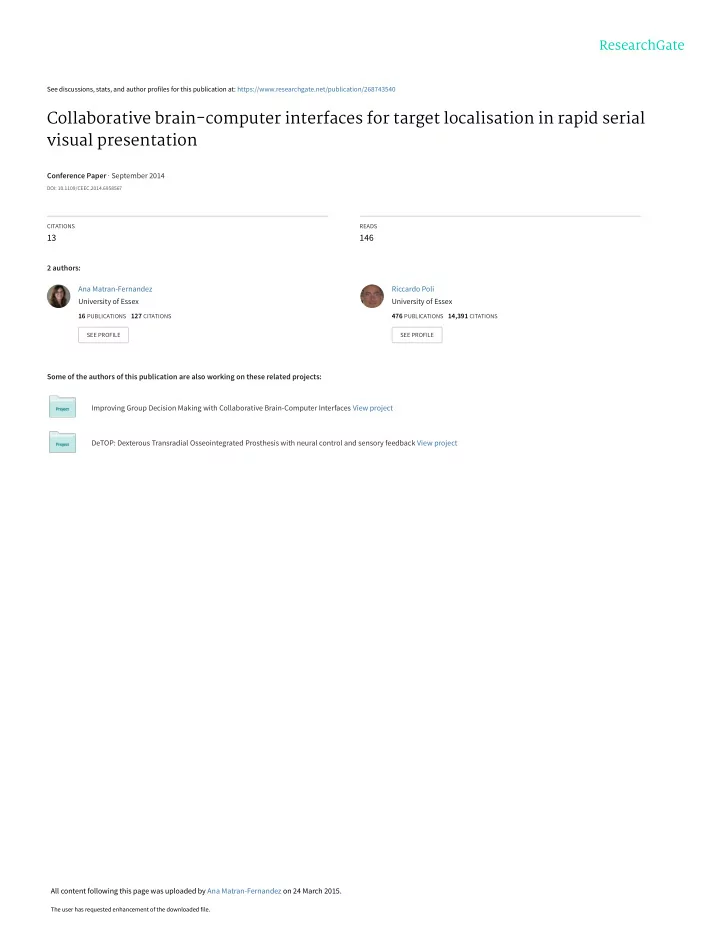

See discussions, stats, and author profiles for this publication at: https://www.researchgate.net/publication/268743540 Collaborative brain-computer interfaces for target localisation in rapid serial visual presentation Conference Paper · September 2014 DOI: 10.1109/CEEC.2014.6958567 CITATIONS READS 13 146 2 authors: Ana Matran-Fernandez Riccardo Poli University of Essex University of Essex 16 PUBLICATIONS 127 CITATIONS 476 PUBLICATIONS 14,391 CITATIONS SEE PROFILE SEE PROFILE Some of the authors of this publication are also working on these related projects: Improving Group Decision Making with Collaborative Brain-Computer Interfaces View project DeTOP: Dexterous Transradial Osseointegrated Prosthesis with neural control and sensory feedback View project All content following this page was uploaded by Ana Matran-Fernandez on 24 March 2015. The user has requested enhancement of the downloaded file.
Collaborative Brain-Computer Interfaces for Target Localisation in Rapid Serial Visual Presentation Ana Matran-Fernandez Riccardo Poli Brain-Computer Interfaces Laboratory Brain-Computer Interfaces Laboratory School of Computer Science and Electronic Engineering School of Computer Science and Electronic Engineering University of Essex University of Essex Colchester CO4 3SQ, UK Colchester CO4 3SQ, UK Email: amatra@essex.ac.uk Email: rpoli@essex.ac.uk stimulus onset) [7], [12]. This ERP is one of the most widely Abstract —The N2pc event-related potential appears on the opposite side of the scalp with respect to the visual hemisphere used ERPs for controlling BCIs (both in traditional and the where an object of interest is located. In this paper, we propose newer paradigms), but it is just one the many components that a 2-user collaborative brain-computer interface that exploits this have been identified in EEG signals. component for the automatic localisation of specific lateral targets Another ERP that can be exploited in BCIs [13] and of in real aerial images displayed by means of the rapid serial visual presentation technique at speeds of 5–15 Hz. By combining the particular interest for this work is the N2pc (a small negative evidence from pairs of users using two different methods and with asymmetric component preceding the P300) which, in the lit- participant selection, we obtain absolute median improvements erature, has predominantly been related to processes associated in the area under the receiver operating characteristic curve of with selective attention [14]–[16]. The N2pc ERP is elicited up to 7.7% with respect to single-user BCIs. when participants are given a search template or object to look I. I NTRODUCTION for and the search display shows at least one distractor (i.e., non-target) item apart from the target. Brain-Computer Interfaces (BCIs) convert electroencephalo- The usual approach to increase the signal-to-noise ratio in graphic (EEG) signals from the brain into commands that BCIs, which are highly contaminated by noise and artifacts, allow users to control devices without the help of the usual is to average signals from different trials to isolate the ERP peripheral pathways. Traditionally, BCIs have been developed of interest [17]. For example, in their N2pc-driven BCI, with the aim of helping people with limitations in their motor Awni et al performed averages across 3 repetitions of the control or their ability to communicate [1]–[3]. However, some stimuli (trials). They reported large variations in classification forms of BCIs have recently started focusing on the augmen- accuracy across participants when discriminating between left tation of human abilities (e.g., speed) of able-bodied users, both individually and in groups by means of collaborative or and right targets (different-colored numbers in a circle) [13]. cooperative BCIs (cBCIs) [4]–[8]. The latter work by merging However, it is not always possible to average across multiple EEG signals (or the corresponding control commands) from trials (e.g., a person cannot make the same decision several multiple users with the aim of controlling a single device. times), or it might not be practical (e.g., when designing BCIs Some of these forms of BCI focus on augmenting visual for healthy users, where speed is a key factor). In this type perception capabilities to speed up the process of finding of situations, aggregating signals from a number of users has pictures of interest in large collections of images [6], [9], [10]. proven to be useful, thus creating a “multi-brain” or cBCI These systems would find applications, for instance, in counter (e.g., [4], [18]). intelligence and policing, where large amounts of images The field of collaborative BCIs is relatively new, and there need to be viewed and classified daily by analysts looking is a lack of consensus on the best way to form groups. Most of for possible threats or, more generally, targets [10]. Apart the work on this area is based on studies about group decision from detecting such targets accurately and at high speeds, it making. The general opinion is that bigger groups lead to stands to reason that current triage systems would benefit from better or more accurate decisions [19]. However, Kao and Couzin [20] showed that in many contexts where this “crowd techniques, such as the one we will present in this paper, that wisdom” effect is not present, small groups can maximize could establish the position of targets within the images. It has been shown that the combination of the Rapid decision accuracy, depending on correlations between the Serial Visual Presentation (RSVP) protocol (which sequen- behavior of the members. In visual perception experiments, tially displays images in the same spatial location at high Bahrami et al found that observers performed better in pairs, presentation rates [11]) with BCIs can effectively reduce triage provided that they had similar visual sensitivities and were time without a detriment in target detection accuracy. This is able to communicate freely [21]. usually achieved by means of the P300 Event-Related Potential With respect to collaborative BCIs, it has been shown that (ERP, a large positive wave typically peaking 300–600 ms after groups are able to accelerate responses with respect to non-
Recommend
More recommend